The iPhone 7 and iPhone 7 Plus Review: Iterating on a Flagship
by Joshua Ho & Brandon Chester on October 10, 2016 8:00 AM EST- Posted in
- Smartphones
- Apple
- Mobile
- iOS
- iOS 10
- iPhone 7
- iPhone 7 Plus
GPU Performance
Section by Brandon Chester
Now that the general system and CPU performance of A10 Fusion has been characterized, we can move on to more focused benchmarks for the GPU and the storage subsystem. Apple's keynote for the iPhone 7 actually disclosed that the GPU in A10 Fusion is a six core part. The last time I recall Apple mentioning specifics about their GPU was with the launch of the iPad 3, where the GPU was advertised as a quad core implementation that turned out to be SGX543MP4.
The use of a six core GPU is interesting because there's not much choice for Apple given that A9 also used the six core PowerVR GT7600. It really boils down to three possibilities. The first is that Apple has actually continued using the exact same GT7600 microarchitecture as on the A9, albeit with an improved layout on the die. The second is that Apple has moved to PowerVR GT7600 Plus, which brings some improvements to integer compute performance, and memory bandwidth optimizations. And the third is the wildcard option - that Apple has put to use its significant GPU engineering resources on a more customized design; something that's still using the PowerVR architecture, but more custom than ever before. This is a longer discussion to have in our full deep dive, but Ryan's of the opinion that this is somewhere between options two and three, that Apple has done some significant work to produce a highly optimized version of the PowerVR GT7600 Plus
In any case, as Apple isn't using a radically different GPU architecture, most of Apple's stated 50% increase in GPU power comes from increasing the clock speeds, with optimizations such as memory and caching picking up the rest. This is interesting because Apple also advertises that A10 Fusion's GPU uses only two thirds the power of A9, which would indicate a lot of work done by Apple to optimize for power usage.


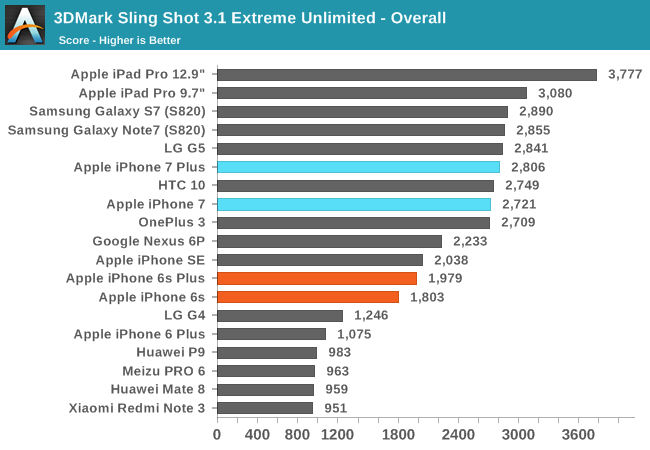
3DMark Sling Shot is broken down into a few different tests, and at the end the results of graphics tests and physics tests produce separate scores which are then used to generate an overall score.
In the graphics test the results are in line with Apple's stated GPU performance improvement of 50%. The physics score, which is really a CPU test, only improves by 30-35%, which has a direct correlation to the increase in peak clock speed from 1.8GHz on A9 to 2.3GHz in A10 fusion.
Like Ice Storm, the physics test is still basically a chart of devices ranked by cores multiplied by max frequency, and you can see that the iPhones have improved very little over the years, with the improvements tracking closely to Apple's increases in CPU clock speed. This comes down to the test being designed in such a way that there's little instruction level parallelism to exploit due to memory dependencies, which puts Apple's wide dual core CPU at a disadvantage. While it is certainly a valid test situation, it's not really reflective of actual 3D game performance because you would generally not write a game in such a way that it cannot exploit the performance of its target hardware.
Even with the smaller improvement in the physics tests, the overall score for the iPhone 7 is still roughly 50% higher than the Apple A9 devices like the iPhone 6s and SE.
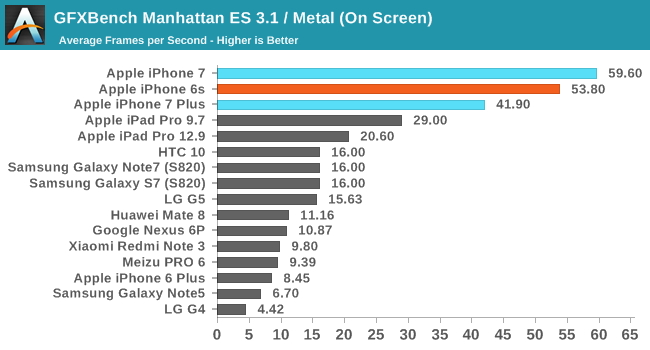
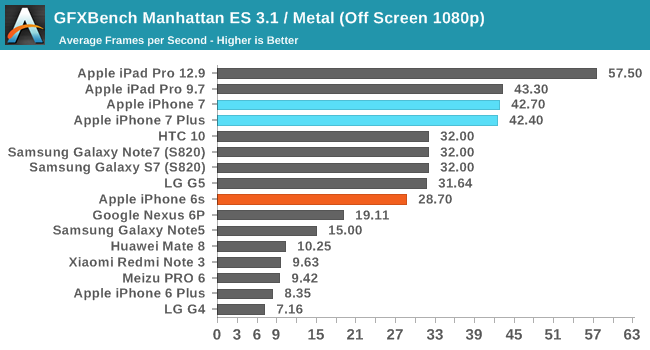
We originally migrated away from Manhattan ES 3.0 to Manhattan ES 3.1 / Metal to push back on devices hitting VSync in the on screen tests. Unfortunately it didn't work for long. With the iPhone 7's increase in GPU performance not being accompanied by an increase in display resolution, the on screen result in GFXBench Manhattan is higher than any other device, and is essentially at the display's refresh limit. The iPhone 7 Plus isn't able to hit Vsync due to its higher resolution, but the on screen result of roughly 42fps is nothing to scoff at either considering the visual complexity of the test.
While on screen performance is helpful from the perspective of someone who wants to see how the phone will actually perform when running a game at its native resolution, to compare directly between devices you need to standardize the rendering resolution. As its name implies, GFXBench's off screen test simply renders all the frames at 1080p in an off screen buffer. In this test the iPhone 7 and 7 Plus both run slightly below 43fps, which puts them right where you'd expect from Apple's claim of 50% greater GPU performance. In GFXBench this also puts the two of them at the same level as the 9.7" iPad Pro for absolute GPU performance.
This gives some interesting insight into the relative clock speeds that Apple is running their GPUs at, as A9X uses a twelve core PowerVR Series7XT GPU, while A10 Fusion uses only six. As I mentioned before, the performance improvements in A10 Fusion primarily come from increasing the peak clock speed. Matching the 9.7" iPad Pro's A9X suggests that Apple has targeted a fairly aggressive clock speed for the GPU in A10 Fusion, and while we can't verify Apple's claim of A10's GPU running at only two thirds the power of A9, if that is indeed the case it would represent a great deal of optimization effort on Apple's part to achieve that despite increasing clock speeds this significantly.
Storage Performance
One of the big changes that came with Apple's A9 and A9X SoCs was a new storage controller designed internally at Apple. This was not the first Apple product to use an in-house SSD controller, as the 2015 MacBook used a PCIe SSD and adopted the NVMe interface. A9 and A9X adapted this for use in mobile, and the sequentual performance in particular was far ahead of anything in a competing mobile device.
Apple hasn't advertised any improvements to storage performance with A10 Fusion, but it's worth running tests to verify that performance has remained at the same level. There are also potential gains in write performance when increasing the total capacity of an SSD by adding additional dies. At this point there's really no benchmark that can give comperable results between iOS and Android, so I've decided against doing a cross-platform comparison here.
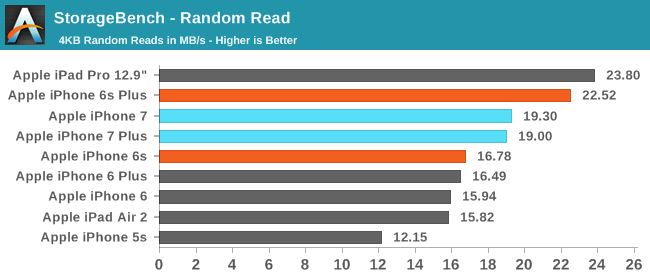
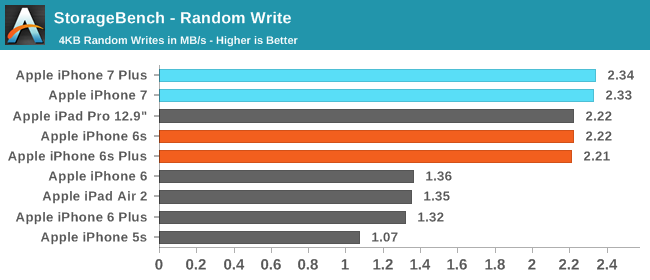

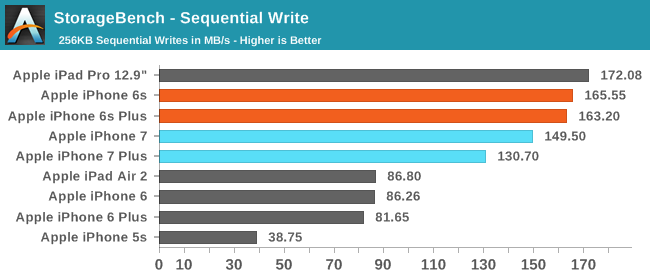
In general, the NAND performance of the iPhone 7 and 7 Plus is equivalent to the iPhone 6s and 6s Plus. There are some minor differences, but essentially all of them can be attributed to testing variance. The only thing that is worth noting is that there's no significant improvement to write performance even though the iPhone 7 units tested are 256GB models while the 6s and 6s Plus were 128GB models. This suggests that the NAND packages use higher capacity dies so there's no additional parallelism to take advantage of.










377 Comments
View All Comments
bw13121 - Monday, October 10, 2016 - link
On the review suggestions, I'm very happy with them all. I would just suggest more of them and a real deep-dive on the A10! Let's see how them 3.3 Billion transistors outpower anything from the Android camp!bw13121 - Monday, October 10, 2016 - link
Also, to add to the comments on the review regarding the slow charge time, does a battery not last longer if it is charged slow as opposed to Fast charging/Qualcomm Quickcharge?The recent issue with Samsung phones could give an indication to the problem associated with fast charging, whether the FC compound or creates any battery issues?
Can AT do another deep dive chemistry wise to compare battery longevity to include the quality of the battery, relative power density and the typical lifespan with the default charger?
Meteor2 - Tuesday, October 11, 2016 - link
By 'last longer' I assume you mean overall lifespan, not the time a single charge lasts. Yes, you're certainly right -- fast charging diminishes the lifespan of lie ion batteries. I swap out fast chargers for 5W chargers for daily use, but keep the OEM 15+W charger plugged in somewhere in case I ever need a fast boost.'Tis true though, USB-C (I.e. really easy to put in) and quick charging largely does away with the need for wireless charging. At least that's my experience.
Meteor2 - Tuesday, October 11, 2016 - link
Good advice.Mumrik - Monday, October 10, 2016 - link
"without a single mention of the deletion of the 3.5mm headphone jack, and that’s mostly because I think removing it doesn’t really matter after spending some time with AirPods, which really do remove a huge number of friction points from the user experience in a way that I didn’t even think about."I'm eternally surprised by the amount of people who happily use whatever headphones come with or are sold for their latest piece of technology.
On my side of the universe, this is more like buying a bluray player and switching your entire TV because they removed HDMI from the player.
Seraphimcaduto - Monday, October 10, 2016 - link
I didn't see anyone already ask the question, so I'll ask, for deep dive are you planning on at the difference that the amount of ram plays between the iPhone 7 and 7+? I remember it coming up during podcast 38 , there was no mention about it later so I thought I would ask great review overall it's why I keep coming back here in and waiting until you do a review before making that purchasing decision.Ryan Smith - Tuesday, October 11, 2016 - link
It's something we're looking into, though it's too early to say if we'll have anything conclusive.df99 - Monday, October 10, 2016 - link
As noted in an earlier comment, there is no mention whatsoever about the Qualcomm Modem X12 -- MDM 9645 and transceivers WTR 4905 and WTR 3925. The combination of the later two chips allows for combining of 3 data streams. There is mention of the WiFi interface in the hardware table but nothing mentioned of the LTE Qualcomm interfaces (CDMA versions of Verizon and Sprint) or the Intel Modem interfaces (AT&T and T-mobile). The Qualcomm modem is Cat 12 DL and Cat 13 UL.The Samsung S7 phones have 4 antennas to support 4x4 MIMO, 256 QAM (DL). To my knowledge, but I don't know for certain and it would be nice if Anandtech told us, there are not 4 antennas in the iPhone 7 so 4x4 MIMO can't be supported. 4x4 MIMO, 256 QAM allow for better signal reach than phones that don't support it. The Samsung S7 phones all use Qualcomm X12 modems as stated earlier, Apple has taken a shortcut and used the Intel modem on AT&T and T-mobile and the Intel modem lacks the 4x4 MIMO support and is a Category 9 modem.
These chips and antennas make a difference for signal performance and I hope Anandtech goes into these very important details.
In addition, as pointed out before, the iPhone 7 and Samsung S7 phones do not have the veer large spectrum AWS-3 (band 66) support. The newest LG phone, the V20 shipping later this month, does have AWS-3, band 66 support.
I also would appreciate the testing of voice quality and noise background noise cancellation comparing the iPhone 7(+) with 6s(+) and Samsung S7.
I have the iPhone 7+ on Verizon and I feel frustrated that Apple's iPhone for Verizon / Sprint which uses the Qualcomm X12 modem does not seem to have the 4 antennas and thus support for 4x4 MIMO and 256 QAM that the Samsung S7 provides. I wish there were more pride on Apple's part to ensure latest technology on the mission critical aspect of the phone (e.g., phones generally not useful if in need of 911 or other important call and can't get signal).
Again, I'm not certain if the iPhone 7(+) does not have the 4 antennas and whether it can soon support 4x4 MIMO and 256 QAM, but I wish the review had mentioned this critical piece of information.
tempestglen - Monday, October 10, 2016 - link
No SPEC2000 or SPEC06 result?RdVi - Monday, October 10, 2016 - link
Just to nit pick, you stated in the intro that the Galaxy S6 had a disadvantage of being thicker than the iPhone 6 which you attribute to the larger battery. The GS6 is actually 0.1mm(!) thinner than the iPhone 6.